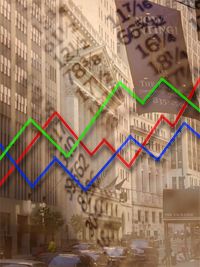|
|

| "Some regard private enterprise as a predatory tiger to be shot. Others look on it as a cow they can milk. A few see it for what it really is - the strong and willing horse that pulls the whole cart along." Allan Greenspan Market Enviroment The United States is re-entering an era of self-empowerment of its citizens in ways that has not been seen for decades. Or experimentation with big government has shown us that big government can be a threat to prosperity. Many government programs begin with good intentions but they continue to grow until the original intent is perverted. Government threats to prosperity are many but the major problems are: market disruptions by burdensome regulations, interference with capital formation by heavy taxation of individuals and businesses, even double taxation of profits paid out as dividends. Much time and effort are spent maneuvering through the tax code and regulatory labyrinths that could have been used creating a greater economy. Monetary policies and attempts to fine tune a multi-trillion dollar economy often lead to inflationary spirals and recessions. Even the Japanese industrial machine has fallen under the weight prey to its own well meaning big government. This movement toward self-empowerment was summed up by Jesse "The Body" Ventura The outspoken governor of Minnesota quoted in the St. Paul Pioneer Press: "Everything in your life you're personally responsible for, in some way or another...too much today someone makes a mistake and the government has to come in and has to right the wrong. That ain't what the government should be doing. That ain't what people should be doing, because that destroys core values." The information age is largely responsible for this transformation. The number of computers hooked up to the internet grew by fifty percent between 1998 and 99. A survey by the NASDAQ stock market in 1997 showed that over forty-three percent of Americans owned stocks or mutual funds, double the number of just seven years before. This could be the best time to be an investor or an entrepreneur since the industrial revolution. Talent and creativity are rewarded as they have never been before. Between 1995 and 98 the number of U.S. households rose by three percent while the number of millionaire households jumped by nearly thirty-seven percent. There has never been a better environment for saving and investing than today. Developing a plan for saving, investing and compounding is all that is needed for the average person to become a millionaire. Market / Economic Cycles and Money Moving Strategies The stock market is said to be a discounting mechanism that adjusts its value on how it views the opportunities future. The economy does not always move through the cycles in the same way. Often the timing and periods that it stays in one phase or another can vary greatly from one cycle to the next. External events political as well as economic crisis may short circuit the orderly evolution from one market phase to the next. In general the market moves through the phases in this order: Recession - The Federal Reserve slows or restricts the growth of the money supply. Interest rates (the cost of the money) go up. These actions are taken to slow and choke off inflationary pressures. If you are a trader this is the best time to buy bonds and the worst time to buy stocks. Basing - Stocks after a few months of falling in value they will loose downward momentum and begin to trade sideways. This can be the start of a market recovery. Buyers and sellers are in equilibrium A good time to move into a cash positions in anticipation for an improving stock markets. Growth - The Federal Reserve Bank maneuvers to a neutral or a monetary expansionary phase to cure the recession by lowering interest rates and increasing the money supply. This is the time to sell bonds and begin to purchase growth stocks and mutual funds.. Inflation - The growth phase continues and accelerates. Growth begins to feed on growth. Manufacturers produce and sell more and more to each other and to the public at large. Companies expand to capitalize on demand that provide materials and services to each other sell more. Demand for industrial products and raw materials. Shortages develop prices rise. Demand for workers increases unemployment drops, and labor demands create labor shortage and higher wages. Workers have higher income to buy more goods and services, creating shortages and higher prices, and the cycle continues until the Federal Reserve contracts the economy, puts the economic breaks on and recreates a new recession. This is a good time to own hard income producing assets such as leveraged real estate. You are gaining appreciation on the real estate while paying for it in cheaper dollars. Topping - If you must sell this is the time, if you can get it right. Markets can go up for years after many people feel that they are in a topping phase. But all good markets come to an end. Declining - Markets fall under their own weight. There is usually a piling-on of inflation, Federal Reserve actions, lack of new money coming into the market, and often an economic or international event that triggers the decline.. This leads us back into recession. During the decline the best investments can be made in shorting the extended highflying stocks of the late growth phase.
|